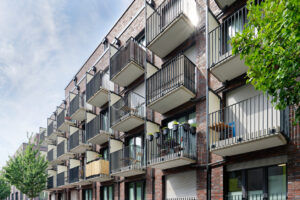For many years, college dorms were characterized by a stark, rustic design—to put it mildly. The dorms provided basic living units constructed using the cheapest and toughest materials available, and often squeezed the largest number of students possible into the smallest space. However, in recent years, student housing design has undergone a fundamental shift as colleges and universities seek to provide students with dormitories that mirror today’s society. The modern student housing design aims to provide an acoustically pleasant and healthy environment for the comfort, protection, and productivity of the learners.
This post will look at ways you can transform the college experience with innovative campus housing design and amenities.
Ways the Modern Dorm Architecture and Innovative Design are Transforming the College Experience
Colleges are increasingly looking to create residential facilities that provide comfort to students, facilitate socialization and engagement, support recruitment and retention of high-caliber students, and provide a foundation for academic success.
Here are the ways modern student housing design helps colleges achieve this feat:
Increased Privacy
Privacy is increasingly becoming a sought-after amenity, with most freshmen joining campus never having shared a room before. With students wanting to choose when and how they socialize, colleges and universities are increasingly incorporating a range of privacy levels. This includes the number of students in a room to the number of students sharing a bathroom. Today, more and more colleges have single bedrooms and are abandoning communal bathrooms in favor of more private-style suite bathrooms shared among only a few students. The increased privacy helps maximize student comfort.
Appealing to Different Living Preferences
Previously, if a college student wanted to live in an apartment, they had to move off-campus. That’s not the case anymore. Today, several colleges are investing in building on-campus apartments. Some colleges are even partnering with private developers to construct student housing off-campus.

Encouraging students to live on campus longer.
By providing students with different types of attractive living spaces, colleges are more likely to encourage students to live on campus longer. This can consequently impact the college’s retention rate and performance. In fact, a study discovered that students who live on campus are often more involved in the campus community, maintain a higher grade point average than students who reside off-campus, and are more likely to complete their degree at their initial institution.
Utilizing Green Materials and Energy
Today, many organizations across various industries, including the higher learning sector, are playing their part in ensuring environmental sustainability. Today, several universities around the world have committed to sustainability and reducing their carbon emissions.

Providing attractive living spaces for students.
Designing environmentally friendly student housing aligns with the goals of most colleges. It also aligns with the values of the students attending currently attending the institution. Additionally, a college’s environmental sustainability initiatives may help it attract prospective students whose values align with those initiatives.
A sustainable student housing design is an excellent way for colleges and universities to show their commitment to sustainability. It’s also a way to demonstrate to students that their institution is innovative, caring, and has the best interest of the world in mind.
Designing with Connections in Mind

Incorporating social areas into a resident hall where students can play and unwind.
Creating spaces that foster connections is a vital part of designing a modern and innovative student dormitory. One of the first places you should focus on when designing student housing to foster connection is the residential halls.
There are a number of ways a student housing architect can incorporate social areas into a resident hall. Incorporating resources such as game rooms, coffee shops, and dining options are some of the excellent ways to increase student connections with their neighbors as well as other members of the campus community.
Focusing on Student Wellness
By incorporating biophilic design and Fitwel and WELL building principles, and design that encourages movement into your new construction or renovation of student housing and residence halls, you will reinforce the idea that student health and wellness are an important part of campus life.
Healthy indoor campus spaces can benefit the mental, physical, and social health of students. This is because it can help encourage healthy choices, allow ample space to relax, and improve focus and productivity.
Increasing Access to Technology
The social life and educational life of students have changed over the years. Today’s college students need access to technology more than ever for educational and social purposes. With more coursework taking place online, it’s important to provide amenities such as multiple outlets for charging various devices, expanded Wi-Fi bandwidth, and other technologies that can make a student’s life on campus more comfortable.
Innovative, Flexible Common Places
Today’s generation of college students desires more privacy. However, that doesn’t mean that colleges and universities have stopped building common spaces. The difference is that modern common spaces are built with specific objectives: they are meant to encourage engagement, help students make connections and build relationships, improve retention, and ultimately help foster academic success.

Providing innovative and flexible common spaces for students.
Colleges are designing innovative, flexible common spaces that feature lounges, study spaces, laundries, and kitchens that are equipped with comfortable furniture that can be moved or configured to accommodate different types of events. Other amenities available in the common rooms include ping pong tables, green screens, innovation incubators, and makers spaces.
Fire-Resistant Student Housing
Student safety should be at the core of student housing design. One of the most common hazards that occur in student dormitories is fire accidents. Studies show that between 2011 and 2015, an estimated annual average of 4,100 fires occurred in dormitories, fraternities, and barracks. These accidents are usually caused by faulty electrical wires.
Building fire-resistant student housing is crucial for protecting both the students and the structure. A vital element of fire-resistant student architecture and construction is passive fire protection. Passive fire protection typically includes fire-resistant doors, exterior walls, roofs, windows, and vents.
Ted Trout Architect & Associates Can Help You with Your Student Housing Project
Ted Trout Architect & Associates designs student housing that promotes collaboration between the needs of administration and municipal concerns. We also help enhance the college experience for students. We are skilled at designing housing that addresses both current and future needs. Our complex level of planning and our deep understanding of building codes and standards ensure that we produce efficient, user-friendly housing that complements existing campus structures as well as the state-of-the-art residential communities that students enjoy living in.
Contact us to learn more about our student housing design service

